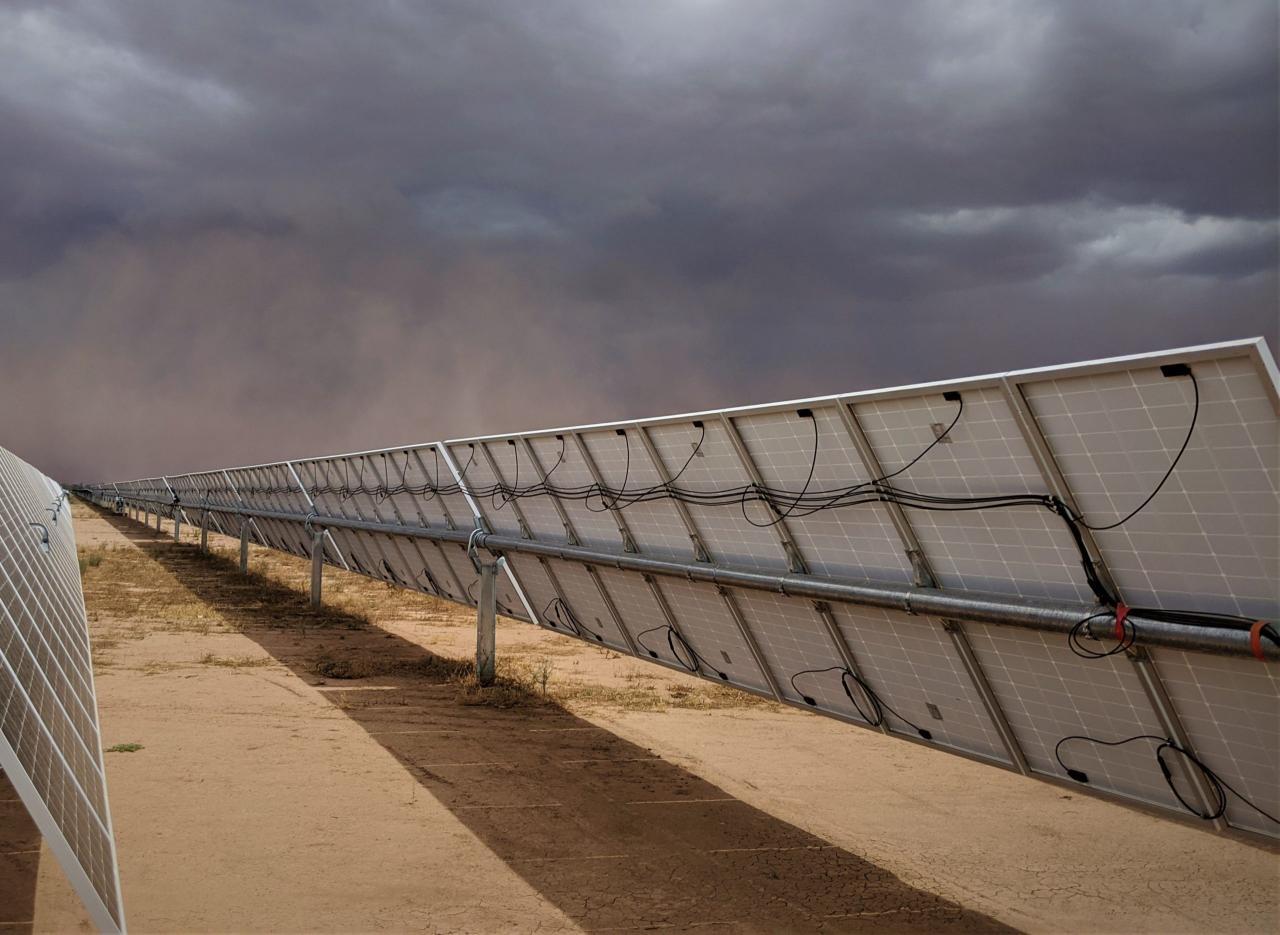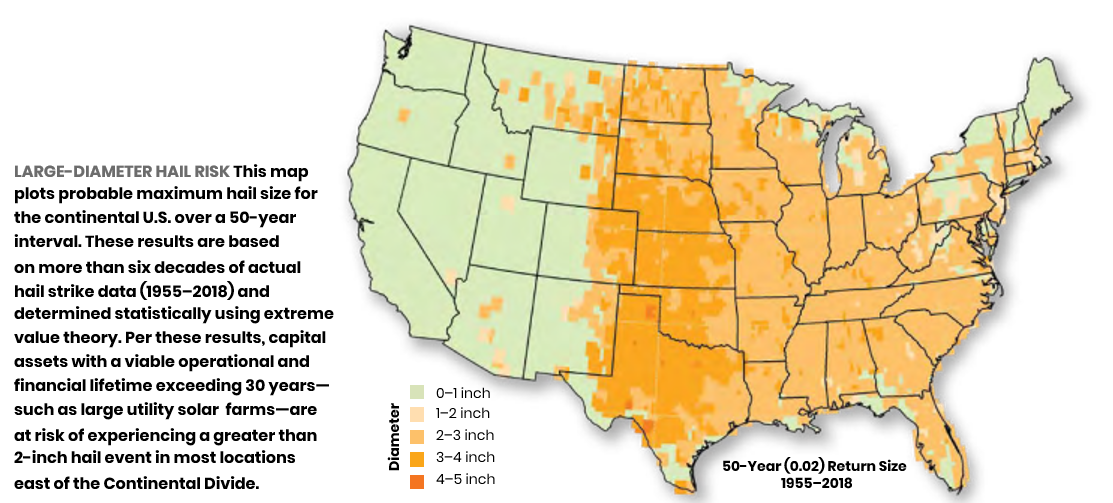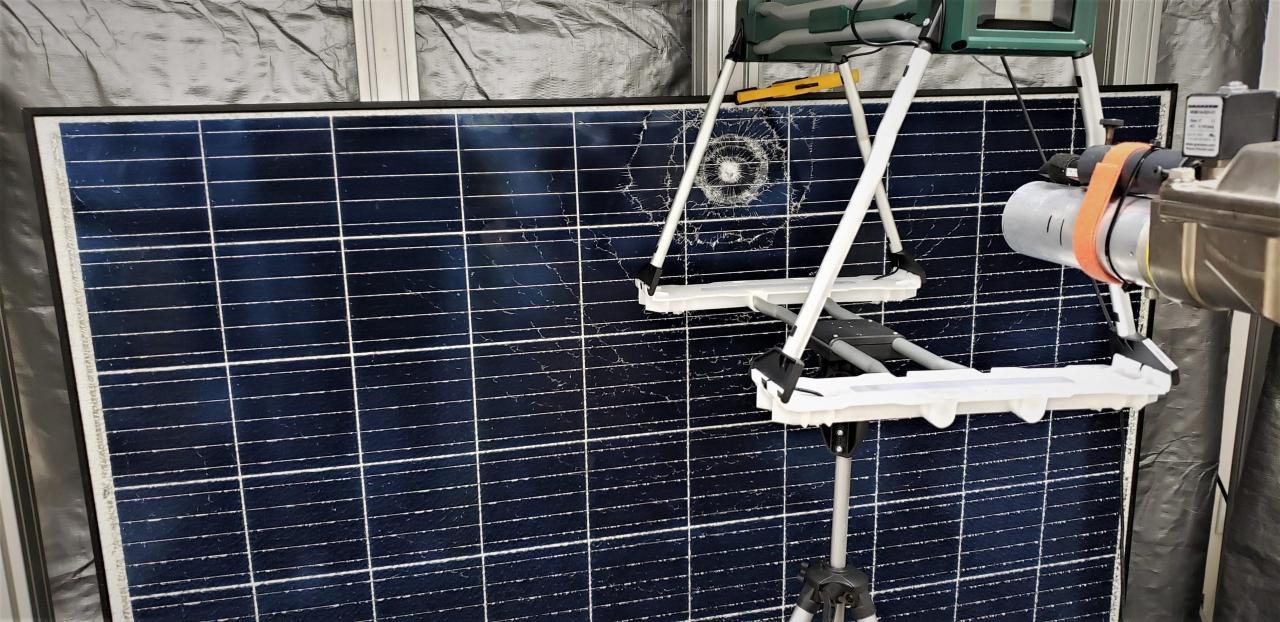冰雹损害对美国大型商用太阳能电站的影响已成为利益相关者最关注的质量,可靠性和资产管理问题。造成这种情况的主要原因之一是位于所谓的美国“冰雹带”(尤其是德克萨斯州)的太阳能项目的大幅增加,那里的一家太阳能发电厂在2019年遭受冰雹袭击而遭受数千万美元的损失,而其他地点也造成了损失。

Nextracker承认,配备了像NX Navigator这样的监视和控制软件的智能,可靠的太阳能跟踪器可以发挥关键作用,以保护太阳能模块并减轻冰雹和其他极端天气风险。我们一直在与开发商,工厂运营商,保险专家和测试实验室进行勤奋的合作,以了解这些极端但反复发生的事件,例如冰雹,并改善行业如何处理这些事件。
我们于2020年11月发布的有关缓解极端天气风险的两本白皮书中的第一篇包括了很大一部分用于冰雹。我的同事Alex Roedel在12月的博客文章中也讨论了该主题。在过去的几个月中,我们参与了一系列有关该主题的新研究和报道,包括PV杂志USA的一篇深度文章,在其中我与编辑Tim Sylvia讨论了一些关键问题。
正如我对蒂姆说的那样,“接受当今对光伏组件进行冰雹测试的方法可能不是正确的做法。处在这个行业,我们需要考虑的是某种差异。我希望业界采取一种“全能”的方法,在这种方法中,它可以集中考虑现有的测试标准,并以不会对所有模块造成不利影响的方式修改严重性阈值。”
我一直在重新评估冰雹影响测试和标准,并与数家合作伙伴一起研究减轻风险的方法,深入研究了气象分析,实验室测试和跟踪器存放策略。在测试和标准方面,最近的NREL PV可靠性研讨会上,与可再生能源测试中心( RETC)的Cherif Kedir一起介绍了一些最新发现和建议。
在演示过程中,我们提供了以下结论:
- 由于在美国中部和东部的大部分地区都部署了经济上有利的公用事业太阳能项目,因此数据显示,这些项目中的组件在其项目生命期内将承受大于25毫米的冰雹影响风险。
- 业界需要基于当前的建筑材料和方法来了解发生故障的风险,尤其是较大的冰雹(直径为50-75毫米/ 2-3英寸)会损坏易受影响的模块。
- 为了降低风险,需要探索主动和被动的材料和方法。

国家海洋和大气管理局(NOAA),2018年。
RETC团队一直在对具有不同物料清单和具有不同尺寸冰雹和冲击能量的前玻璃厚度的不同PV模块进行广泛的测试。研究结果强烈表明,当前的ASTM E1038和IEC 61215 PV模块冰雹测试标准允许的历史上接受的最低测试规范可能不足以解决冰雹所带来的区域性高度风险,因此应重新评估。我们建议业界考虑将模块部署在何处,尽快组成一个工作组来检查冰雹风险。

2020年在可再生能源测试中心进行冰雹测试
RETC测试的其中一项收获是,像我们的NX Horizon和NX Gemini系统这样的智能存储跟踪器如何在冰雹暴风雨中发挥积极作用,以最大程度地减少对模块的损坏。通过在即将发生冰雹时将跟踪器的倾斜度调整为15-30度(取决于模块前玻璃的厚度),测试结果表明,可以安全地将50毫米以上的冰雹从模块前玻璃上偏转,从而大大减少了任何撞击损坏模块。
我还一直与Allen Weather Risk咨询公司的John Allen合作进行冰雹分析和积载策略,以更深入地了解与冰雹相关的主题,包括:
- 回顾冰雹数据的来源(及其准确性)。
- 美国大陆上冰雹大小分布的网格化估计,以及冰雹对该网格中映射的各个区域的影响概率。
- 风和冰雹如何相互作用以及如何影响冰雹的影响轨迹。
- 对可用于预测资产所有者和经营者冰雹的系统的评估。
Nextracker将利用这些发现,不仅使我们的系统更灵活,更智能,而且可以帮助我们的客户以及整个行业评估,预测和减轻冰雹对其发电厂造成损害的潜在风险。
可以在此处找到Nextracker的两本白皮书的下载链接,这些白皮书可减轻公用事业太阳能发电厂的极端天气风险。
第一部分:
第二部分:
1619168662-Nextracker_White_Paper_Mitigating_Extreme_Weather_Risk_Part_2
作者:
原文:
By
The impact of hail damage on U.S. utility-scale solar plants has become a top-of-mind quality, reliability and asset management issue for stakeholders. One of the main reasons for this is the huge uptick in solar projects located in the so-called U.S. “hail belt,” especially Texas, where one solar plant suffered tens of millions of dollars in damage from a hailstorm in 2019 and other sites have incurred losses as well.
Nextracker has acknowledged the key role that smart, reliable solar trackers equipped with monitoring and control software like NX Navigator can play to protect solar modules and mitigate hail and other extreme weather risks. We have been working diligently with developers, plant operators, insurance experts, and testing labs to understand these extreme but recurring events such as hail and improve how the industry deals with them.
The first of our two white papers on mitigating extreme weather risk, published in November 2020, included a significant portion devoted to hail. My colleague Alex Roedel also discussed the topic in his blog post in December. Over the past few months, we have been involved in a flurry of new studies and reporting on the topic, including an in-depth article by PV magazine USA, where I discussed some of the key issues with editor Tim Sylvia.
As I told Tim, “accepting the way that PV modules are tested today for hail might not be the right thing to do going forward. What we as an industry need to consider is some sort of a differentiation. I expect the industry to take an ‘all-in’ approach, in which it takes a collective look at existing testing standards and modifies the severity thresholds in a way that does not penalize all modules.”
I have been working on the reevaluation of hail impact testing and standards as well as investigating risk mitigation approaches with several partners, taking a deep dive into meteorological analyses, lab testing and tracker stow strategies. On the testing and standards front, some of the latest findings and recommendations were presented along with Cherif Kedir of the Renewable Energy Test Center (RETC) at the recent NREL PV Reliability Workshop.
We offered the following conclusions during our presentation:
- Since utility solar projects with favorable economics are being deployed in much of the central and eastern U.S., the data shows that modules in those projects will be exposed to >25 mm hail impact risk within their project lifetimes.
- The industry needs to understand the risk of failure based on current construction materials and methods, especially how susceptible modules are to damage from larger (50-75 mm/2-3-inch-diameter) hailstones.
- In order to reduce risk, active and passive materials and methods need to be explored.

National Oceanic and Atmospheric Administration (NOAA), 2018.
The RETC team has been conducting extensive testing of different PV modules with different bills of materials and front-glass thicknesses with different-sized hailstones and impact energies. The findings strongly suggest that the historically accepted minimum testing practice allowed in the current ASTM E1038 and IEC 61215 PV module hail testing standards may be inadequate to address the highly regional-specific risk posed by hail and should be reevaluated. We recommend that the industry form a task force as soon as possible to examine hail risk, taking into consideration where the modules will be deployed.

Hail Test at Renewable Energy Test Center, 2020
One of the takeaways from RETC’s testing is how smart-stowing trackers like our NX Horizon and NX Gemini systems can play an active role in minimizing damage to the modules during a hailstorm. By adjusting the tracker tilt to 15-30 degrees (depending on the module front-glass thickness) when a hailstorm is imminent, test results show that 50-mm-plus hailstones can be safely deflected off the module front glass, greatly reducing any impact harm to the modules.
I have also been working with John Allen of the Allen Weather Risk consultancy on hail analysis and stow strategies to get a deeper understanding of hail-related topics, including:
- A review of the sources of meteorological hail data (and their veracity).
- A gridded estimation of hail-size distribution in the continental U.S., and the probability of hail impact on the various areas mapped in that grid.
- How wind and hail interact and how that affects the hail impact trajectory.
- An assessment of the systems available to anticipate hailstorms for asset owners and operators.
Nextracker will use these findings to not only make our systems more resilient and smarter, but to help our customers—and the industry—evaluate, predict and mitigate the potential risks of hail damage to their power plants.
Download links for Nextracker’s two white papers on mitigating extreme weather risk to utility solar plants can be found here.









